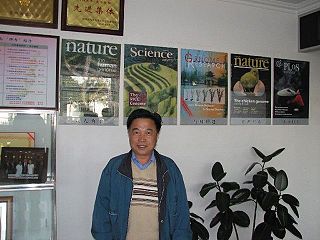History
Wang Jian, Yu Jun, Yang Huanming and Liu Siqi created BGI in November 1999, [4] in Beijing, China as a non-governmental independent research institute in order to participate in the Human Genome Project as China's representative. [5] [6] After the project was completed, funding dried up. So BGI moved to Hangzhou in exchange for funding from the Hangzhou Municipal Government. In 2002, BGI sequenced the rice genome which was a cover story in the journal Science. In 2003 BGI decoded the SARS virus genome and created a kit for detection of the virus. In 2003, BGI Hangzhou and the Zhejiang University founded a new research institute, the James D. Watson Institute of Genome Sciences, Zhejiang University. The Watson Institute was intended to become a major center for research and education in East Asia modeled after the Cold Spring Harbor Laboratory in the US.

Yang Huanming, also known as Henry Yang, is one of China's leading genetics researchers. He is Chairman and co-founder of the Beijing Genomics Institute, formerly of the Chinese Academy of Sciences. Yang received his B. Sc from Hangzhou University in 1978, followed by a master's degree in biology in 1982 from the Nanjing Railroad Medical Institute. Yang earned his Ph.D in 1988 in the Institute of Medical Genetics University of Copenhagen, Denmark. He then completed his post-doctoral training in Europe and the United States. He was elected as member of the Chinese Academy of Sciences in 2007, a foreign academician of Indian National Science Academy in 2009, a member of the German National Academy of Sciences in 2012, and foreign associate of the US National Academy of Science in 2014.

The Human Genome Project (HGP) was an international scientific research project with the goal of determining the sequence of nucleotide base pairs that make up human DNA, and of identifying and mapping all of the genes of the human genome from both a physical and a functional standpoint. It remains the world's largest collaborative biological project. After the idea was picked up in 1984 by the US government when the planning started, the project formally launched in 1990 and was declared complete on April 14, 2003. Funding came from the US government through the National Institutes of Health (NIH) as well as numerous other groups from around the world. A parallel project was conducted outside government by the Celera Corporation, or Celera Genomics, which was formally launched in 1998. Most of the government-sponsored sequencing was performed in twenty universities and research centers in the United States, the United Kingdom, Japan, France, Germany and China.

Hangzhou formerly romanized as Hangchow, is the capital and most populous city of Zhejiang Province in East China. It sits at the head of Hangzhou Bay, which separates Shanghai and Ningbo. Hangzhou grew to prominence as the southern terminus of the Grand Canal and has been one of the most renowned and prosperous cities in China for much of the last millennium. The city's West Lake, a UNESCO World Heritage site immediately west of the city, is among its best-known attractions. A study conducted by PwC and China Development Research Foundation saw Hangzhou ranked first among "Chinese Cities of Opportunity". Hangzhou is also considered a World City with a "Beta+" classification according to GaWC.
In 2007 BGI's headquarters relocated to Shenzhen as "the first citizen-managed, non-profit research institution in China". Yu Jun left BGI at this time purportedly selling his stake to the other 3 founders for a nominal sum. [4] In 2008, BGI-Shenzhen was officially recognized as a non-profit organization by Shenzhen government. [7] In 2008, BGI published the first human genome of an Asian individual. [5] [8]

Shenzhen is a major city in Guangdong Province, China; it forms part of the Pearl River Delta megalopolis, bordering Hong Kong to the south, Huizhou to the northeast, and Dongguan to the northwest. It holds sub-provincial administrative status, with powers slightly less than those of a province.
In 2010 BGI Shenzhen was certified as meeting the requirements of ISO9001:2008 standard for the design and provision of high-throughput sequencing services, [9] The same year BGI bought 128 Illumina's HiSeq 2000 gene-sequencing machines, [3] [5] which was backed by US$1.5 billion in "collaborative funds" over the next 10 years from the China Development Bank. [4] [10] [11] By the end of the year, they reportedly had a budget of $30 million. [12] In 2010, BGI Americas was established with its main office in Cambridge, Massachusetts, USA, and BGI Europe was established in Copenhagen, Denmark. [13] [14] By 2018, they were expanded with offices and laboratories in Seattle and San Jose in USA, [3] and London in the UK, as well were founded BGI Asia Pacific with offices in Hong Kong, Kobe (Japan), Bangkok (Thailand), Laos, Singapore, Brisbane (Australia) and many others. [15] [16]
The China Development Bank (CDB) is a financial institution in the People's Republic of China (PRC), led by a cabinet minister at the Governor level, under the direct jurisdiction of the State Council. As one of three policy banks in China, it is responsible for raising funds for large-scale infrastructure projects, including the Three Gorges Dam and the Shanghai Pudong International Airport. Established by the Policy Banks Law of 1994, the bank is described as the engine that powers the national government’s economic development policies.

Cambridge is a city in Middlesex County, Massachusetts, and part of the Boston metropolitan area.
In 2011 BGI reported it employed 4,000 scientists and technicians, [2] and had a $192 million in revenue. [4] BGI did the genome sequencing for the deadly 2011 Germany E. coli O104:H4 outbreak in three days under an open license. [17] Since 2012 it started to commercialize its services, having investments from China Life Insurance Company, Citic's Goldstone Investment, Jack Ma's Yunfeng Capital, and SoftBank China Capital. [18] In 2013 BGI reported it had relationships with 17 out of the top 20 global pharmaceutical companies, [4] [19] and advertised that it provided commercial science, health, agricultural, and informatics services to global pharmaceutical companies. [20] That year it bought Complete Genomics of Mountain View, California, a major supplier of DNA sequencing technology, for US$118 million. [4] [17] In the same year, the BGI was roughly valued at $820 million. [4]

A novel strain of Escherichia coli O104:H4 bacteria caused a serious outbreak of foodborne illness focused in northern Germany in May through June 2011. The illness was characterized by bloody diarrhea, with a high frequency of serious complications, including hemolytic-uremic syndrome (HUS), a condition that requires urgent treatment. The outbreak was originally thought to have been caused by an enterohemorrhagic (EHEC) strain of E. coli, but it was later shown to have been caused by an enteroaggregative E. coli (EAEC) strain that had acquired the genes to produce Shiga toxins, present in organic fenugreek sprouts.

China Life Insurance Company Limited is a Beijing-based China-incorporated company that provides life insurance and annuity products. China Life is ranked No. 94 on Fortune 2015 Global 500 Company list. China Life, which is 70% state-owned, is the biggest life insurer in China, but is coming off a few rocky years. China's insurance market attracted dozens of new competitors after the Chinese government liberalized it, and China Life's market share has fallen by almost half since 2007, from 50% to around 26%, according to Morningstar. The company is completing a major restructuring, and the government assigned it a new CEO in 2014. A new sales push early this year led to a big bump in net income in the first quarter of 2015. China Life is also ranked on Fortune China: 2015 Top 500 Chinese Enterprises at No.13.

Jack Ma is a Chinese business magnate, investor, and philanthropist. He is the co-founder and executive chairman of the Alibaba Group, a multinational technology conglomerate. as of January 2019, he is one of China's richest men with a net worth of US$36.2 billion, as well as one of the wealthiest people in the world. Ma's primary ideology was for an open and market-driven economy.
In 2015, they signed a collaboration with the Zhongshan Hospital' Center for Clinical Precision Medicine in Shanghai, opened in May 2015 with a budget of ¥100 million. They are reportedly being involved as a sequencing institution in China's US$9.2-billion research project for medical care which will last for 15 years. [3] [21] In May 2017, was announced formation of West Coast Innovation Center, co-located in Seattle and San Jose, on the first location planned to work on precision medicine and feature collaborations with University of Washington, the Allen Institute for Brain Science, the Bill & Melinda Gates Foundation, and Washington State University, while on the second's already existing laboratory with 100 employees to develop the next-generation sequencing technologies. [3] In May 2018, was reached an agreement with Mount Sinai Hospital (Toronto), Canada, for first installation of BGISEQ platforms in North America. [22]

Zhongshan Hospital, formerly Chung Shan Memorial Hospital, is a major teaching hospital in Shanghai, China, affiliated with the Shanghai Medical College of Fudan University.

The University of Washington is a public research university in Seattle, Washington.

The Allen Institute for Brain Science is a Seattle-based independent, nonprofit medical research organization. Founded in 2003, it is dedicated to accelerating the understanding of how the human brain works. With the intent of catalyzing brain research in different areas, the Allen Institute provides free data and tools to scientists.
The BGI Group subsidiary, BGI Genomics, had made initial public offering in July 2017 at Shenzhen Stock Exchange, raising ¥547 million ($80.7 million), with company's first-day valuation set at over $1.15 billion. [1] [23] In 2018, the BGI was reportedly 85.3% owned by Wang Jian, and the group owns 42.4% of its main unit BGI Genomics. The reported market value for BGI Genomics in July 2018 was around $5 billion, as is of another subsidiary, MGI Tech, specialized in developing and manufacturing technology, which IPO of a stake of about 20% for $1 billion is scheduled for 2019 in Hong Kong. [18]
In 2010, the institute 500-node supercomputer processed 10 terabytes of raw sequencing data every 24 hours from its current 30 or so Genome Analyzers from Illumina. The annual budget for the computer center was US$9 million. [12] In the same year, BGI's computational biologists developed the first successful algorithm, based on graph theory, for aligning billions of 25 to 75-base pair strings produced by next-generation sequencers, specifically Illumina’s Genome Analyzer, during de novo sequencing. The algorithm, called SOAPdenovo, can assemble a genome in two days and has been used to sequence an array of plant and animal genomes. [29]
SOAPdenovo is part of "Short Oligonucleotide Analysis Package" (SOAP), a suite of tools developed by BGI for de novo assembly of human-sized genomes, alignment, SNP detection, resequencing, indel finding, and structural variation analysis. Built for the Illumina sequencers' short reads, SOAPdenovo has been used to assemble multiple human genomes [25] [26] [27] (identifying an eight kilobase insertion not detected by mapping to the human reference genome [59] ) and animals, like the giant panda. [24]
Until 2015, BGI had released BGISEQ-100, based on Thermo Fisher Scientific's Ion Torrent device, and BGISEQ-1000, based on similar technology by Complete Genomics, for both of which received an approval from the CFDA for a NIFTY noninvasive prenatal test. [60] [61] In October 2015, BGI launched BGISEQ-500, [62] a larger desktop sequencing system, which received an approved registration as a medical device a year later by the CFDA. It reportedly received more than 500 orders for the system and run over 112,000 tests until late 2016. [61] The China National GeneBank, opened by BGI and Chinese Government in September 2016, [63] has 150 instruments of the system. [61] The BGISEQ-500 was developed as a sequencing platform capable of competing with Illumina's platforms with its quality and reduced price. [60] In November 2016, BGI launched BGISEQ-50, a miniature version of desktop sequencer. [64] In 2017, BGI began offering WGS for $600. [3] In October 2017, MGI Tech, a subsidiary of BGI, launched two new sequencers MGISEQ-2000 and MGISEQ-200, [65] while a year later MGISEQ-T7. [66]






















